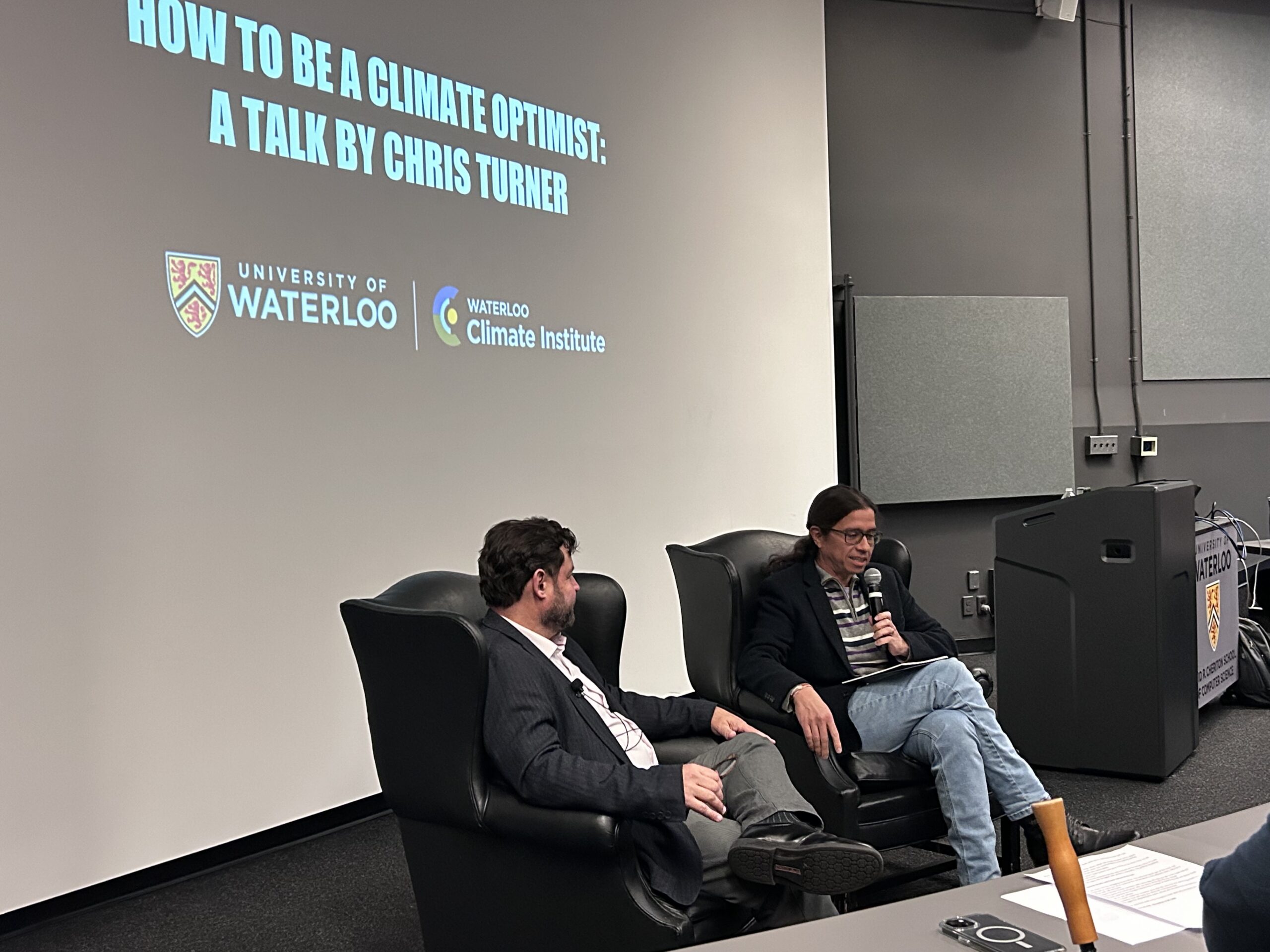Why climate fatalism will be our downfall, and what we can do about it
| October 11, 2024

Two people sit in armchairs on a stage, engaging in a discussion. A projection behind them reads “How to Be a Climate Optimist: Solutions and Insights by Chris Turner,” with logos for the University of Waterloo and Waterloo Climate Institute.
Two people sit in armchairs on a stage, engaging in a discussion. A projection behind them reads "How to Be a Climate Optimist: Solutions and Insights by Chris Turner," with logos for the University of Waterloo and Waterloo Climate Institute.
On Oct. 8, the Waterloo Climate Institute hosted Chris Turner, Canadian climate journalist and author of The Geography of Hope and The Patch, to talk about how we can become climate optimists in the face of increasingly prevalent environmental crises. Turner, aware that the dominant narrative of our time is that of doom and apocalyptic ecological crises, was primarily concerned with dispelling some major misconceptions without diminishing the urgency of the issue – he wished to instill optimism without its often accompanied complacency. His talk thus focused on the lesser-reported technological developments in renewable energy and socio-political shifts towards green design within the last two decades.
In this age of blisteringly fast news cycles creating stories engineered to gain the most clicks, it’s really no surprise that climate catastrophism – the belief that the climate problem cannot be solved in time to prevent all-out societal collapse – runs rampant among our younger generations. Articles detailing sweltering temperatures, longer drought seasons, faster hurricane winds, and more damaging storm surges seem never-ending. On the other hand, good news on climate change appears to be increasingly harder to come by. Furthermore, social media algorithms often promote content that elicits strong emotional reactions, amplifying the feeling of hopelessness that is brought on by climate catastrophism.
A byproduct of such algorithmic manipulation is overwhelming despair, which often provokes fatalism – a surrender to fated and unavoidable climate catastrophe – rather than the activism that is necessary. Apocalypse Soon?, a 2010 study by Eddie Peptione, found that “dire messages warning of the severity of global warming and its presumed dangers can backfire, paradoxically increasing skepticism about global warming.”
In his talk then, Turner offered many examples of communities that have successfully transitioned to renewable energy or more sustainable living to show that progress can indeed be made. He showed photos of towns in Southern Germany where houses have been powered entirely by solar panels since 2005. Successful grassroots movements to convert commuter neighborhoods in Texas to be pedestrian-friendly were also a hot topic of discussion, considering how often we believe ourselves powerless to effect change. Bayer Street, a road running parallel to the touristy Banff Avenue in Alberta, was also a particularly remarkable example in how it completely overhauled its streetscape from a car-dominated thoroughfare to a walkable, community-centered space.
The talk ended on a hopeful note regarding the degrees of warming that Turner expects in the coming decades. “I’m inclined to look at things like what’s happened to solar and battery storage and electric vehicles and everything else in the last 10 years, and assume that the next 10 years are probably going to see an acceleration in our adoption of solutions, rather than a leveling off or a decline,” he said. “And so I might even get, you know, crazy enough to say whether we hit it by 2030 or not, that… there is a viable trajectory to 1.7 to maybe 1.8 degrees [as opposed to the previously proposed 2.1-2.4 degrees].”
It can be hard to remain hopeful amidst constant news of environmental devastation, but Turner’s message reminds us that progress is still being made. If we continue to work hard and hold faith in our continued innovation and collective action, a sustainable future will definitely be within our grasp.






